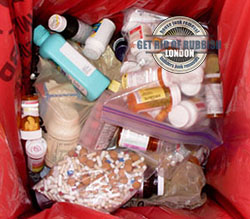The growth of the international pharmaceutical industry has resulted in increased amounts of post-pharmaceutical production waste. Up to now, not many local or national authorities considered pharmaceutical waste a problem, perhaps there wasn’t too much of it. However, water and soil samples taken from a number of large cities in different parts of the world have showed troubling results – large amounts of drugs and pharmaceutical substances – the problem especially evident in drinking water.
A new form of technology which is already available for commercial use is expected to deal effectively with all types of pharmaceutical waste. The machine uses a combination of strong oxidising agents and high alkaline environment in order to neutralise all types of pharmaceutical waste.
 So how does pharmaceutical waste end up in the environment? Quite easily actually, and in this case pharmaceutical companies and households (end users) share the blame. In recent years a whole host of new pharmaceuticals have been developed and made widely available to households and industry. Many of these are haphazardly discarded without thinking about it too much. For instance, medications and pharmaceutical supplies frequently end up in the bin at best, or down the toilet most of the time. This is common practice in many households – when a drug or pharmaceutical supply expires or goes unused for long periods of time – whoosh it is tossed out. Even worse is the common practice in some clinics and medical facilities where such medical supplies and pharmaceutical chemicals are discarded along with clinical waste stream. Pharmaceutical companies sit on the two extremes of the pollution scale – usually when the production plant is based in a well-developed country residues and waste are burnt and destroyed in high tech incinerators. On the other hand, production plants in developing countries have been known to dispose of leftovers as bluntly as burying them in the ground.
So how does pharmaceutical waste end up in the environment? Quite easily actually, and in this case pharmaceutical companies and households (end users) share the blame. In recent years a whole host of new pharmaceuticals have been developed and made widely available to households and industry. Many of these are haphazardly discarded without thinking about it too much. For instance, medications and pharmaceutical supplies frequently end up in the bin at best, or down the toilet most of the time. This is common practice in many households – when a drug or pharmaceutical supply expires or goes unused for long periods of time – whoosh it is tossed out. Even worse is the common practice in some clinics and medical facilities where such medical supplies and pharmaceutical chemicals are discarded along with clinical waste stream. Pharmaceutical companies sit on the two extremes of the pollution scale – usually when the production plant is based in a well-developed country residues and waste are burnt and destroyed in high tech incinerators. On the other hand, production plants in developing countries have been known to dispose of leftovers as bluntly as burying them in the ground.
The new pharmaceutical waste management technology/equipment uses a non-thermal commercially scalable process as an alternative to incineration. The combination of high alkaline environment and strong oxidising agents allows effective destruction of all types of pharmaceutical waste. The technology and subsequently the equipment it uses were developed in Spain as part of an intergovernmental program. For short the equipment and technology is known as MIMO.
MIMO uses different types of oxidising agents as per the type of pharmaceutical waste being destroyed. The equipment is able to process infectious, cytostatic/non-cytostatic pharmaceutical waste. MIMO is before all a machine so in many respects it resembles existing waste processing equipment – it consists of a feeding unit where waste is introduced and then moved to a shredding unit where it is chopped down to a more manageable size. Next step is feeding the shreds into the actual reactor unit where oxidation and destruction actually takes place. Final step of the process is stabilising the residue prior to landfill transfer. During stabilisation any remaining molecules are converted into their least soluble form in order to prevent leachates (liquids containing undesirable contaminants) or reduce chance of toxic substances draining out of landfills.
